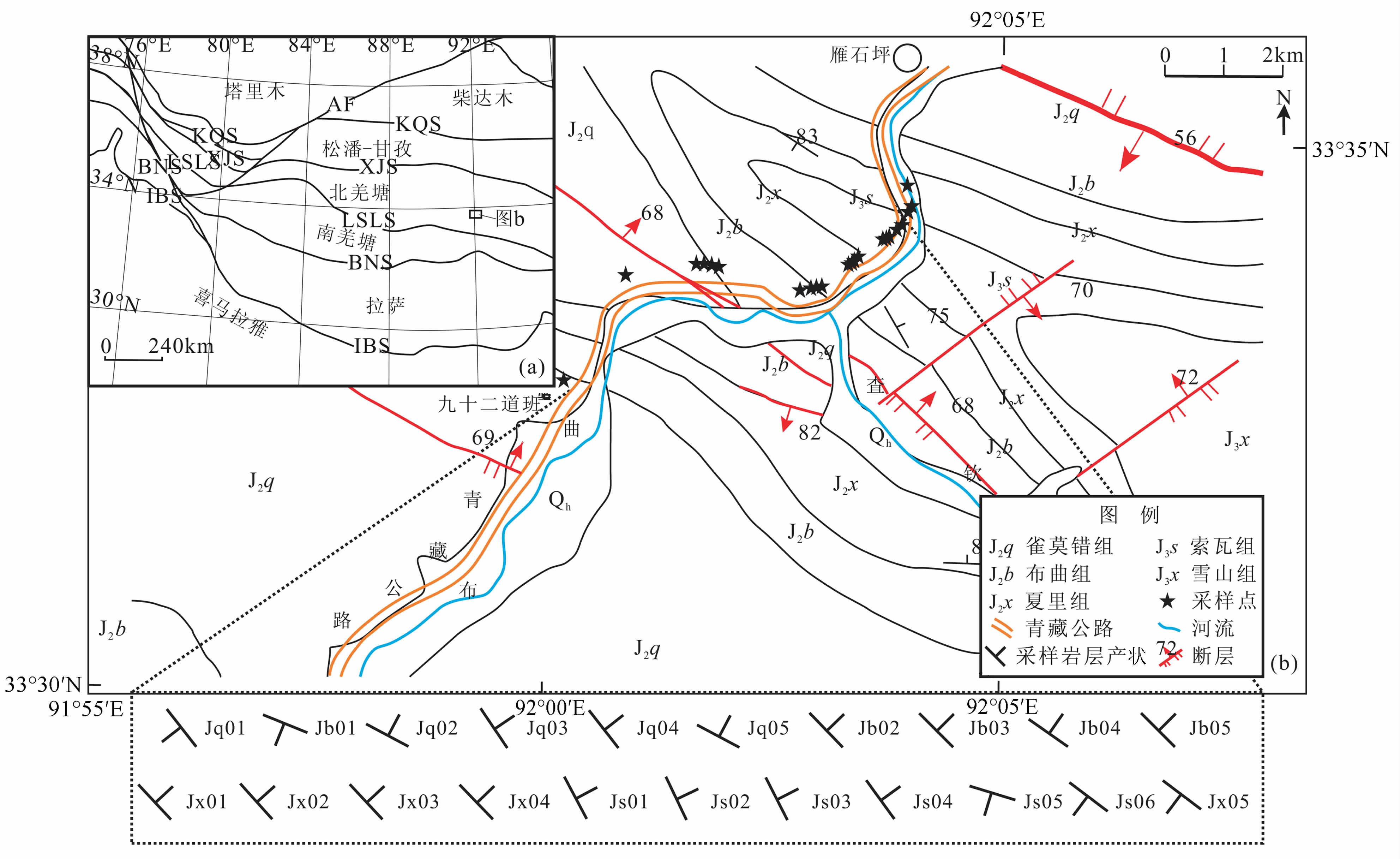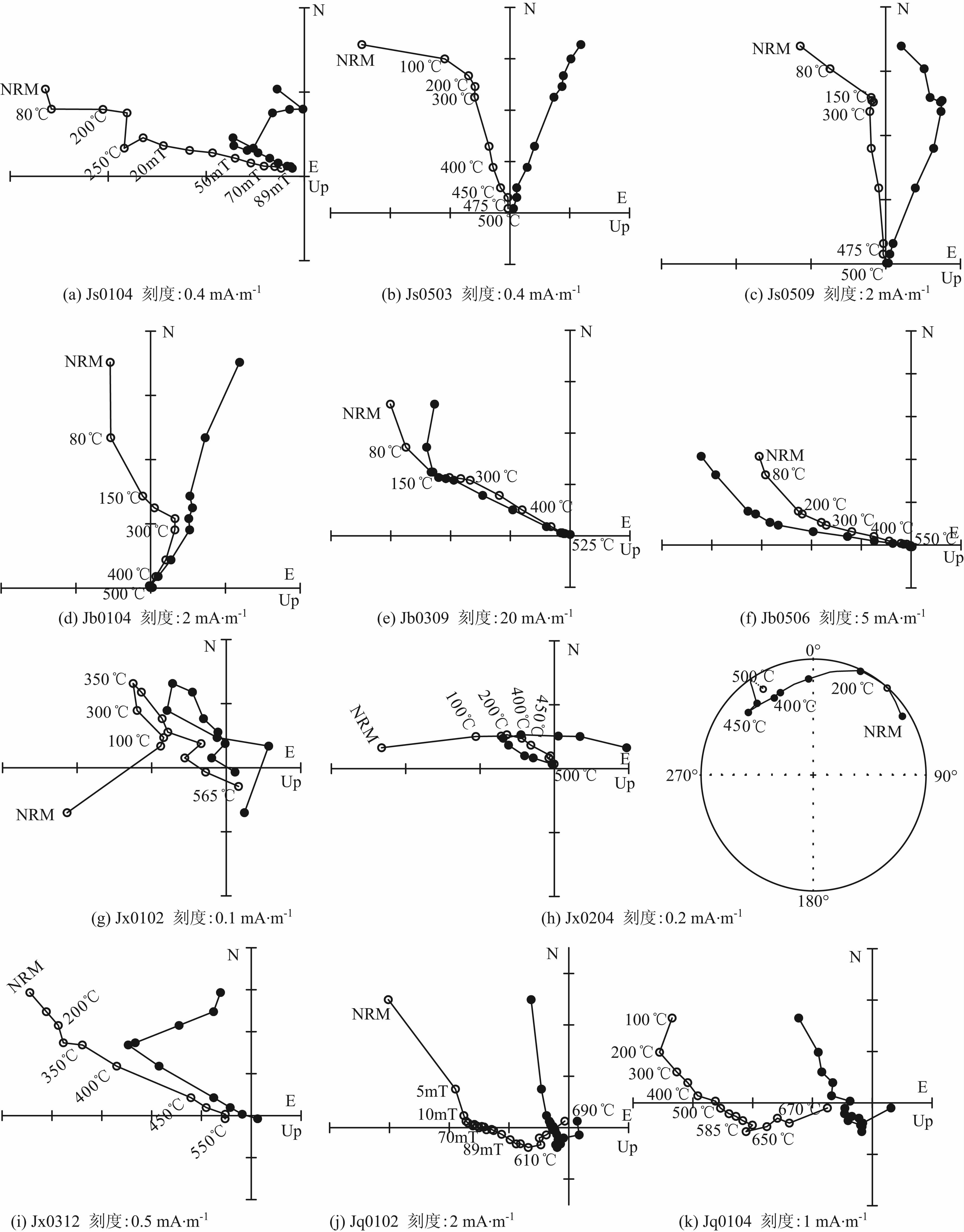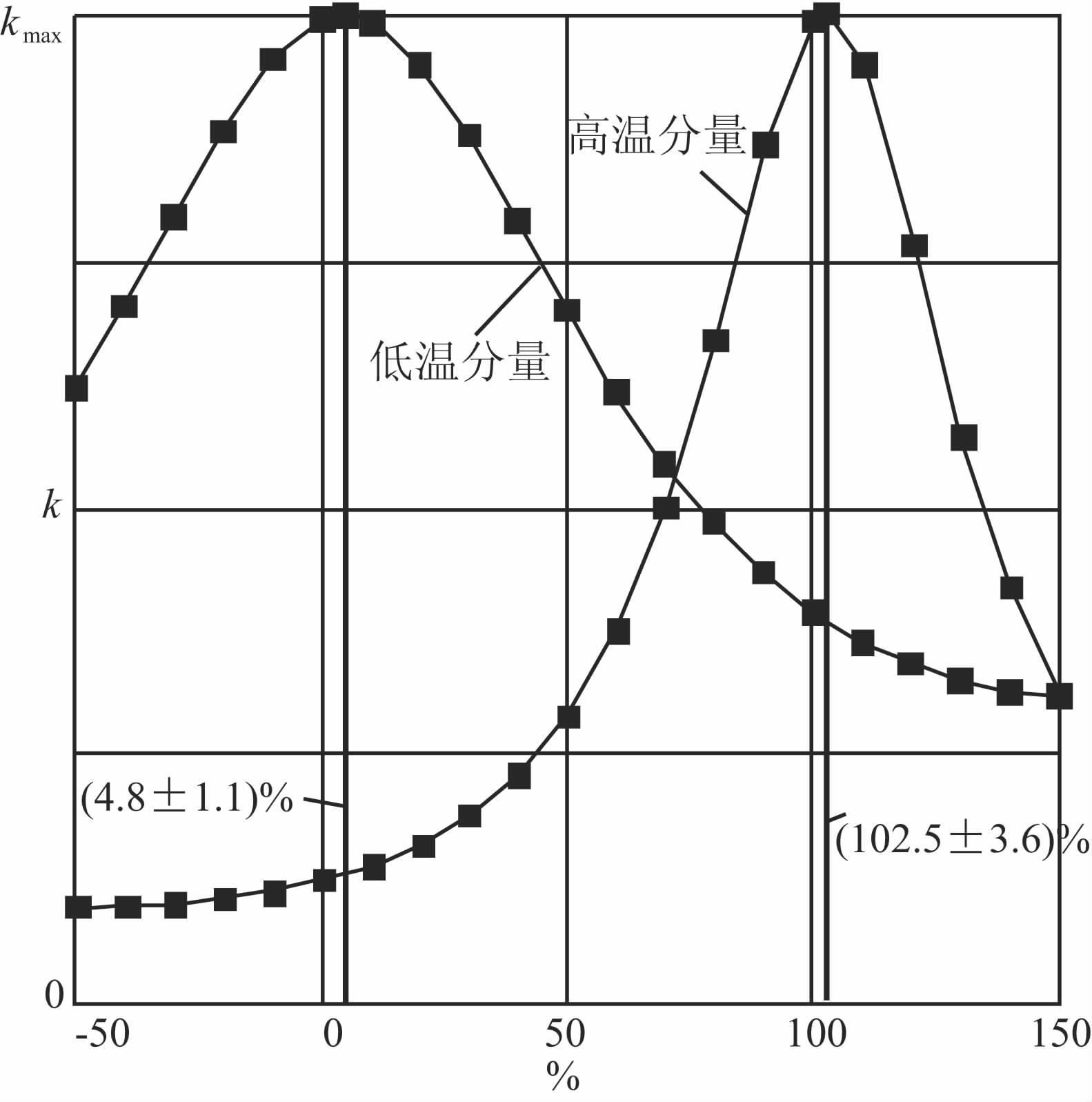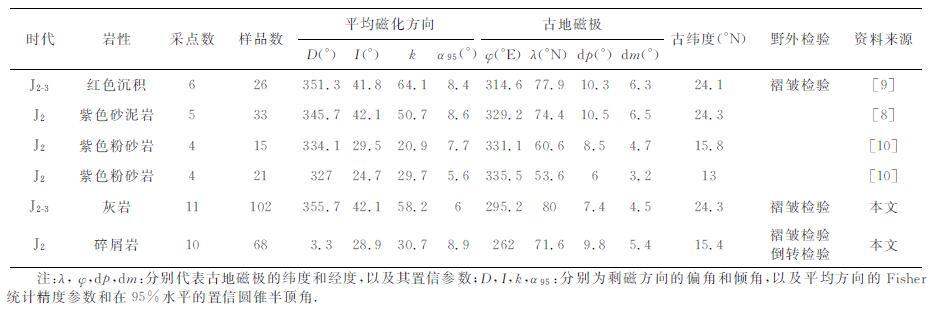2. 中煤科工集团西安研究院, 西安 710054;
3. 中油测井青海事业部, 甘肃敦煌 736202;
4. 中国地质调查局西安地质调查中心, 西安 710054
2. Xi'an Branch, China Coal Research Institute, Xi'an 710054, China;
3. Qinghai Division of China National Logging Corporation, Gansu Dunhuang 736202, China;
4. Xi'an Institute of Geology and Mineral Resource, China Geological Survey, Xi'an 710054, China
羌塘是解决古特提斯演化和冈瓦纳与欧亚大陆界线问题的关键地区之一[1-5].确定羌北地块中生代古地理位置及演化,对于研究青藏高原内部构造以及特提斯洋演化历史等均具有重要意义.20世纪八九十年代开始,中外学者陆续在羌塘地区开展古地磁研究工作[6-10],但由于自然条件及当时实验室测试设备、分析技术等的限制,所获得数据之间存在较多的矛盾.已有的可靠性较高的古地磁结果仍不足以厘定羌北地块显生宙以来的构造演化过程,以及其在特提斯演化过程中的真实意义[11].我们近年来在羌北双湖和藏东开心岭地区晚古生代及早中生代地层进行了较为深入细致的古地磁学研究,获得了羌北-昌都地块晚石炭至早三叠世的较为可靠的古地磁数据,阐述了该地块晚古生代的构造演化及其与冈瓦纳大陆北缘的关系问题[12-13].本文报道羌北地区中-晚侏罗世雁石坪群的古地磁新结果,并结合已发表的古地磁数据,讨论羌北-昌都地块中-晚侏罗世的古地理位置及构造演化过程.
2 区域地层概况与样品采集侏罗系是羌塘地区发育最全、分布最广泛的层系[14].中-上侏罗统雁石坪群为一套海相碳酸盐岩与碎屑岩为主组成多个旋回的沉积,岩石地层以“三砂夹二灰"为特征,下部局部地区夹火山岩[14-19].自下而上分为中侏罗统雀莫错组(J2q)、布曲组(J2b)、夏里组(J2x)、和上侏罗统索瓦组(J3s)、雪山组(J3x),各组之间沉积连续,产双壳类、腕足类、腹足类、菊石和孢粉等化石,其时代属于巴柔期-提塘期[18-19].雁石坪群不整合于上三叠统结扎群及其以前地层之上,与上覆白垩系下统呈角度不整合接触,表明燕山运动第一幕对套层系的影响[20-24]1).
1)青海1∶25万温泉兵站幅(I46C003002)区域地质调查报告.四川:成都理工大学地质调查院,2005.
采样地区位于青藏公路雁石坪沿线,中-上侏罗统雁石坪剖面交通便利,露头良好,层序清楚,分层标志较明显,化石丰富,是羌北地区的典型剖面[17].该剖面包含中侏罗统雀莫错组(J2q)、布曲组(J2b)、夏里组(J2x)、和上侏罗统索瓦组(J3s)四个岩石地层单位,各岩石地层单位间均为整合接触关系,与下伏三叠系结扎群巴贡组呈断层接触,上部由索瓦组组成向斜1).本次研究共布置21 个采点,采集独立定向样品217块(图 1).其中,于中侏罗统雀莫错组(J2q)和夏里组(J2x)两个砂岩组分别布置5个采点(共采样99 块),岩性主要为紫红色、灰绿色细粒岩屑石英砂岩或紫红色泥岩;于中侏罗统布曲组(J2b)和上侏罗统索瓦组(J3s)两个灰岩组分别布置5和6 个采点(共采样118 块),岩性主要为灰黑色泥晶-微晶灰岩.采点布置尽量位于褶皱两翼,以便于做褶皱检验.样品的采集使用Mode1Do26-T6 便携式钻机取岩芯样品,配合使用Mode1OR-2 定向器和磁罗盘对钻孔岩芯进行定向,利用GPS测定采样点地理坐标经、纬度值.

|
图 1 研究区大地构造简图(a)及采样区地质简图(b)(据 1)修改) IBS,印度河-雅鲁藏布江缝合带;BNS,班公湖-怒江缝合带;LSLS,龙木错-双湖-澜沧江缝合带;XJS,西金乌兰-金沙江缝合带;KQS,康西瓦-昆南-玛沁缝合带;AF,阿尔金断裂. Fig. 1 (a) Simplified tectonic map of the northern Qiangtang Region, and(b) simplified geological map of the sampling locality (modified from 1)) IBS,Indus River-Yarlung Zangbo River suture; BNS,Bangong Lake-Nujiang River suture; LSLS,Lungmu Co-Shuanghu-Lancang River suture; XJS,Xijir Ulan-Jinsha River suture; KQS,Kengxiwar-Kunnan-Maqen suture; AF,Altun Fault. |
为了鉴定标本中的主要磁性矿物,在每个采点中选取1块代表性样品,进行了饱和等温剩磁(SIRM)获得曲线和三轴等温剩磁的系统热退磁实验[25].SIRM 的获得采用2G-660 脉冲磁力仪,测量采用JR-5A 旋转磁力仪;三轴等温剩磁通过对样品三个相互正交的Z、Y和X轴分别施加2700、500 和50mT的脉冲磁场,然后进行系统热退磁,退磁及测量分别采用了MMTD-48 热退磁炉和2G-755R 低温超导磁力仪.所有室内实验工作均在中国科学院地质与地球物理研究所古地磁学实验室进行[26].
根据上述岩石磁学实验所揭示出的样品的矫顽力谱和阻挡温度谱特征,可将样品的主要磁性矿物组合分为以下几种类型(图 2):(1)上侏罗统索瓦组(J3s)和中侏罗统布曲组(J2b)的灰岩样品(图 2a,2b),以及中侏罗统夏里组(J2x)的灰绿色砂岩样品(图 2c)均显示出磁铁矿为主的特征:SIRM 曲线在较低的磁化场阶段(约小于200mT)迅速达到准饱和.三轴等温剩磁的热退磁曲线显示,软磁成分和中间磁成分占主导且具有约580 ℃左右(布曲组(J2b)灰岩为500℃左右)的阻挡温度,表明样品中的主要载磁矿物为低矫顽力的磁铁矿.(2)中侏罗统雀莫错组(J2q)的灰绿色细粒岩屑石英砂岩样品(图 2d)中赤铁矿与磁铁矿共存:样品的SIRM 曲线在小于200mT 的磁化场下迅速增加,之后随着外加磁场的增强,至2.7T 时仍未达到饱和.三轴等温剩磁的热退磁曲线显示,软磁成分和中间磁成分在580 ℃左右解阻,硬磁成分在670℃左右解阻,表现出赤铁矿与磁铁矿共存的特征.(3)中侏罗统雀莫错组(J2q)紫红色砂岩(图 2f)和夏里组(J2x)紫红色泥岩(图 2e)样品均显示出赤铁矿为主的特征:SIRM曲线随外加磁场增强,至2.7T仍未达到饱和.三轴等温剩磁的热退磁曲线显示,软磁成分含量很低,中间磁成分和硬磁成分占主导地位,两者均具有约670 ℃左右的阻挡温度,表现出赤铁矿为主的特征.

|
图 2 代表性样品等温剩磁获得曲线及三轴等温剩磁热退磁曲线 软磁成分(<0.04T);中间磁成分(0.04~0.4T);硬磁成分(0.4~2.7T). Fig. 2 Normalized isothermal remanent magnetization acquisition curves (IRM),andthermal demagnetization of three-axis IRM for representative samples The sott (〈0.04 T),medium (0.04〜0.4 T),and hard (0.4〜2.7 T) components are shown during thermal demagnetization. |
根据岩石磁学结果,选择逐步热退磁或交变退磁,或者最高温度小于300 ℃的逐步热退磁与交变退磁复合的方法对全部样品进行了系统磁清洗,以获得稳定的特征剩磁(ChRM).系统热退磁使用MMTD-48热退磁炉,热退磁的温度间隔在低温阶段选择50~100 ℃,高温阶段为10~25 ℃;交变退磁采用2G-660 辅助交变退磁仪,退磁间隔为5~10mT.剩磁测量在2G-755R 低温超导磁力仪上完成.样品的退磁和测量均在中心小于300nT 的磁屏蔽空间中进行.剩磁组分的分离主要采用Kirschvink主向量分析法[27],部分样品使用重磁化大圆弧法[28];剩磁方向的统计平均采用球面单位矢量的Fisher统计平均[29]或单位矢量和重磁化大圆弧的混合平均[30].
(1) 上侏罗统索瓦组(J3s)和中侏罗统布曲组(J2b)灰岩样品的退磁曲线具有明显的双分量特征.低温分量在300 ℃之前被消除.J3s灰岩的特征剩磁分量(ChRM)通常出现在300~500 ℃ (或20~89mT)之间(图 3a-3c),J2b灰岩的高温特征剩磁分量(ChRM)可以在300~550℃之间获得(图 3d-3f).

|
图 3 倾斜校正前代表样品的系统退磁矢量Z氏图[31](●水平面投影○垂直面投影),及部分样品地层坐标系下退磁矢量的赤平投影图(●下半球投影○上半球投影) Fig. 3 Orthogonal vector plots in geographic coordinates and stereoplots in stratigraphic coordinates for representativesamples.Circle, represent vertical component in orthogonal plots or upper hemisphere in stereoplots; dot, representhorizontal component in orthogonal plots or lower hemisphere in stereoplots |
(2) 中侏罗统雪山组(J2x)和雀莫错组(J2q)灰绿色砂岩,以及中侏罗统雪山组(J2x)紫红色泥岩样品具有相对复杂的退磁特征.大部分样品在350 ℃(或20mT)之前可以除去低温黏滞剩磁,350~585 ℃之间获得稳定的特征剩磁分量(ChRM)(图 3g,3i).少部分样品高温阶段的退磁曲线在赤平投影图上显示出重磁化弧的特征(图 3h),可以用带限制点的重磁化大圆弧交汇法处理[28].
(3) 中侏罗统雀莫错组(J2q)紫红色砂岩的退磁曲线具有双分量或三分量特征,三分量曲线的中温分量应该为低、高温分量叠加所致.低温分量通常在300 ℃ 以前被分离,高温特征剩磁分量(ChRM)通常可在585~690 ℃之间获得(图 3j,3k).
雁石坪群共有115块样品获得低温剩磁分量,其平均方向在地层校正前后分别为:Dg=353.1°,Ig=40.7°,k=8.5,α95=4.8°和Ds=0.2°,Is=11.4°,k=3.4,α95=8.5°.该剩磁组分具有显著的负褶皱检验结果(kg/ks=8.5/3.4),逐步校正分析表明其最大集中程度出现在(4.8±1.1)%的地层倾斜校正水平上(图 4),该分量为褶皱后的次生磁化组分.

|
图 4 中-晚侏罗世雁石坪群剩磁分量逐步校正分析示意图 Fig. 4 Proportional unfolding tests for the low- and high-temperature components, respectively |
各采点的高温特征剩磁分量平均方向如表 1、图 5所示.雁石坪群21个采点的高温分量方向的总平均方向在地层校正前后分别为:Dg=321.5°,Ig=37.7°,k=3.9,α95=18.5°和Ds =359.6°,Is =35.9°,k=31.9,α95=5.7°.该分量方向在99%置信水平上通过了McElhiny 褶皱检验(1964)[32] 和McFadden褶皱检验(1990)[33],逐步校正分析[34]表明其最大集中程度出现在(102.5±3.6)%的倾斜校正水平上(图 4),表明其应为岩石褶皱之前获得的剩磁.值得注意的是,J2q紫红色砂岩样品退磁曲线中存在指向南的负倾角和指向北的正倾角两种,两类分量在地层坐标系下呈对趾分布,在95%置信水平上可通过倒转检验[35](γ0=9.819206<γc=14.63663,C 级倒转检验).如前所述,晚侏罗世-早白垩世随着班公湖-怒江洋的最终关闭及全面碰撞造山作用,区域上表现为强烈挤压碰撞造山,在该动力学体制下,侏罗系地层发生褶皱变形,形成中生代侏罗系与白垩系区域性角度不整合[20-24].因此,雁石坪群正的褶皱检验结果表明ChRM 应该为中-晚侏罗世的原生剩磁信息.
|
|
表 1 中-晚侏罗世雁石坪群样品的特征剩磁分量 Table 1 Paleomagnetic data for the high-temperature component |

|
图 5 中-晚侏罗世雁石坪群高温特征分量赤平投影图 ○上半球投影;●下半球投影;☆总平均方向;▲现代地磁场方向. Fig. 5 Equal-area stereoplots of the high-temperature components with associated confidence circles.The left plots are in situ, right plots are in tilt-corrected Open (closed) symbols represent upper (lower) hemisphere projections; stars indicate the overalt-mean directionswith 95 % confidence limits; and ladder-shaped indicate the present dipole field (PDF) direction. |
前人曾对雁石坪侏罗系剖面做过一些古地磁学研究(表 2)[8-10],这些古地磁数据在95% 置信区间内并不一致,计算出的古纬度存在10°左右的差异,多数结果也没有给出较详细的退磁及处理过程,以至于构造学家们在这些成果中难以选择和采用.我们的结果引导了一个选择的方向.
|
|
表 2 中-晚侏罗世雁石坪群古地磁极位置 Table 2 Middle-Late Jurassic paleomagnetic poles for the Yanshiping Group reference |
本研究在雁石坪群海陆交互相沉积中采集21个采点217块样品,包括J3s和J2b灰岩组和J2x和J2q碎屑岩组,经过详细的岩石磁学及古地磁学分析,获得了中-晚侏罗世的原生剩磁信息.我们同时注意到,同时代沉积的碎屑岩(J2x、J2q)和灰岩(J3s、J2b)组高温特征剩磁分量平均方向的偏角相同,倾角有13°左右的差异,据此可将雁石坪群剩磁方向细分为两类(表 1):(1)索瓦组(J3s)和布曲组(J2b)灰岩,以磁铁矿为主要载磁矿物,高温特征剩磁分量(Ds=355.7°,Is=42.1°,k=58.2,α95=6°)可通过99%置信度的褶皱检验.(2)雪山组(J2x)和雀莫错组(J2q)碎屑岩,以赤铁矿、磁铁矿为主要载磁矿物,高温特征剩磁分量(Ds=3.3°,Is=28.9°,k=30.7,α95=8.9°)可通过95%置信度的倒转检验和99%置信度的褶皱检验.通过褶皱检验表明,两组分量都应该是中-晚侏罗世的原生剩磁信息.这么大的差异显然不能仅仅以统计误差来解释,也不能解释为羌北地块于中晚侏罗世阶段存在快速往复的南北向运动.本文认为,尽管有研究成果认为雁石坪群碎屑岩中高温成分的载磁矿物为胶结物中的褐铁矿和赤铁矿[10],其得到的剩磁方向与我们的J2x和J2q碎屑岩组的方向很接近(表 2).相对于J3s和J2b的纯灰岩样品以磁铁矿为主要载磁矿物,J2x和J2q碎屑岩组剩磁方向很可能存在着与压实作用相关的剩磁倾角变浅的情况,而13°左右的倾角差也与前人实验得出的粉砂质泥岩和泥质粉砂岩在压实过程中产生的磁倾角浅化幅度较为吻合[36-37].而且,灰岩的抗压强度一般比砂岩要大,尤其是在软硬相间层状碳酸盐岩夹碎屑岩地层中,灰岩的抗压强度可达碎屑岩的10倍以上,成岩后体积变量很小,故本文认为雁石坪群纯灰岩地层中剩磁方向应该未受压实作用引起的磁倾角浅化的影响.选择J3s和J2b的11 个纯灰岩采点的平均方向统计雁石坪群古地磁结果,其对应的古地磁极位置为:80.0°N,295.2°E(dp/dm=7.4/4.5).雁石坪(33.6°N,92.1°E)在中晚侏罗世的古纬度为24.3°N,中-晚侏罗世之后羌北块体仍北向移动900km 左右.

|
图 6 雁石坪群古地磁极位置(★灰岩组获得的极位置;☆碎屑岩组获得的极位置) Fig. 6 Comparison of Middle^Late Jurassic paleomagneticpoles for the Yanshiping Group (★pole from limestone; ☆pole from sandstone) |
我们的研究表明,羌北-昌都地区晚石炭-晚二叠世期间在南纬中低纬度地区徘徊,于晚二叠至早三叠世开始大规模北向移动,与现今位置相比的运动总量达5000km 以上(表 3,另文发表).结合本文的结果可以推断,羌北地块的快速北向运动主要发生在早中生代期间(3500±1000km),如果要对这一演化过程进行详细厘定,则三叠纪可靠的古地磁研究结果就相当重要.
|
|
表 3 羌北-昌都地区古地磁结果 Table 3 Summary of paleomagnetic poles from the northern Qiangtang-Qamdo block |
本研究的实验工作得到中国科学院地质与地球物理研究所黄宝春研究员,秦华峰、蔡书慧、刘成英、乔庆庆、易治宇等同志的指导和帮助,审稿专家提出了建设性的意见和建议,在此一并表示感谢.
| [1] | 常承法. 特提斯及青藏碰撞造山带的演化特点.//徐贵志, 常承法主编. 大陆岩石圈构造与资源. 北京: 海洋出版社, 1992: 1-8. Chang C F. Tethys and the evolutional characteristics of collision orogen in Qinghai-Tibet plateau. //Xu G Z, Chang C F eds. Tectonics and Resources of Continental Lithosphere (in Chinese). Beijing: Ocean Press, 1992: 1-8. |
| [2] | 李才, 翟刚毅, 王立全, 等. 认识青藏高原的重要窗口——羌塘地区近年来研究进展评述(代序). 地质通报 , 2009, 28(9): 1169–1177. Li C, Zhai G Y, Wang L Q, et al. An important window for understanding the Qinghai-Tibet Plateau-A review on research progress in recent years of Qiangtang area, Tibet, China. Geological Bulletin of China (in Chinese) , 2009, 28(9): 1169-1177. |
| [3] | 任纪舜, 肖黎薇. 1: 25万地质填图进一步揭开了青藏高原大地构造的神秘面纱. 地质通报 , 2004, 23(1): 1–11. Ren J S, Xiao L W. Lifting the mysterious veil of the tectonics of the Qinghai-Tibet Plateau by 1: 250000 geological mapping. Geological Bulletin of China (in Chinese) , 2004, 23(1): 1-11. |
| [4] | 潘桂棠, 王立全, 朱弟成. 青藏高原区域地质调查中几个重大科学问题的思考. 地质通报 , 2004, 23(1): 12–19. Pan G T, Wang L Q, Zhu D C. Thoughts on some important scientific problems in regional geological survey of the Qinghai-Tibet Plateau. Geological Bulletin of China (in Chinese) , 2004, 23(1): 12-19. |
| [5] | 李荣社, 杨永成, 孟勇. 青藏高原1: 25万区域地质调查主要成果和进展综述(北区). 地质通报 , 2004, 23(5-6): 421–426. Li R S, Yang Y C, Meng Y. Main results and progress in 1: 250000 regional geological survey of the northern Qinghai-Tibet Plateau. Geological Bulletin of China (in Chinese) , 2004, 23(5-6): 421-426. |
| [6] | 朱志文, 朱湘元, 张一鸣. 西藏高原古地磁及大陆漂移. 地球物理学报 , 1981, 24(1): 40–49. Zhu Z W, Zhu X Y, Zhang Y M. Palaeomagnetic observation in Xizang and continental drift. Chinese J. Geophys. (Acta Geophysica Sinica) (in Chinese) , 1981, 24(1): 40-49. |
| [7] | 叶祥华, 李家福. 古地磁与西藏板块及特提斯的演化. 成都地质学院学报 , 1987, 14(1): 65–79. Ye X H, Li J F. Palaeomagnetism and evolution of Tibet plates and Tethys. Journal of Chengdu College of Geology (in Chinese) , 1987, 14(1): 65-79. |
| [8] | 张文治, 张金起. 青藏高原北部构造演化的古地磁证据. //'97全国古地磁学、环境磁学与岩石磁学学术会议. 上海, 1997. Zhang W Z, Zhang J Q. Paleomagnetic constraints on the northern Tibetan Plateau tectonic evolution. //'97 National Paleomagnetism, Environmental Magnetism and Rock Magnetism Academic Conferences (in Chinese). Shanghai, 1997. |
| [9] | 林金录. 中国古地磁数据表(2). 地质科学 , 1989(4): 400–404. Lin J L. China paleomagnetic data list (2). Scientia Geologica Sinica (in Chinese) , 1989(4): 400-404. |
| [10] | 董学斌, 王忠民, 谭承泽, 等. 青藏高原古地磁研究新结果. 地质论评 , 1991, 37(2): 160–164. Dong X B, Wang Z M, Tan C Z, et al. New results of paleomagnetic studies of the Qinghai-Tibet Plateau. Geological Review (in Chinese) , 1991, 37(2): 160-164. |
| [11] | 孙丽莎, 黄宝春, 陈军山. 青藏高原诸块体的显生宙运动学与特提斯洋的演化. //金翔龙, 秦蕴珊, 朱日祥主编. 中国地质地球物理学研究进展——庆贺刘光鼎院士八十华诞. 北京: 海洋出版社, 2008: 54-65. Sun L S, Huang B C, Chen J S. The Phanerozoic kinematic characteristics of the blocks in Qinghai-Tibet Plateau and their implications for Tethyan evolution (in Chinese). //Jin X L, Qin Y S, Zhu R X eds. Progress in Geological and Geophysics of China-Celebrate the 80th Birthday of Liu Guangding Academician. Beijing: Ocean Press, 2008: 54-65. |
| [12] | 程鑫, 吴汉宁, 郭强, 等. 青藏高原羌北地块晚古生代古地磁研究的初步结果. 中国科学D辑: 地球科学 , 2012, 55(8): 67–75. Cheng X, Wu H N, Guo Q, et al. Paleomagnetic results of Late Paleozoic rocks from northern Qiangtang Block in Qinghai-Tibet Plateau, China. Sci. China Earth Sci. (in Chinese) , 2012, 55(8): 67-75. |
| [13] | 程鑫. 青藏高原羌塘地块晚古生代古地磁研究. 西安: 西北大学, 2009. Cheng X. Paleomagnetic results of the Late Paleozoic rocks from northern Qiangtang block in Qinghai-Tibet Plateau, China (in Chinese). Xi'an: Northwest University, 2009. |
| [14] | 赵政璋, 李永铁, 叶和飞, 等. 青藏高原地层. 北京: 科学出版社, 2001 . Zhao Z Z, Li Y T, Ye H F, et al. Qinghai-Tibet Plateau Strata (in Chinese). Beijing: Science Press, 2001 . |
| [15] | 谭富文, 王剑, 李永铁, 等. 羌塘盆地侏罗纪末-早白垩世沉积特征与地层问题. 中国地质 , 2004, 31(4): 400–405. Tan F W, Wang J, Li Y T, et al. Late Jurassic-Early Cretaceous strata and their sedimentary characteristics in the Qiangtang basin, northern Tibet. Geology in China (in Chinese) , 2004, 31(4): 400-405. |
| [16] | 贾建称, 吴新国, 王根厚, 等. 羌塘盆地东部中生代沉积特征与构造演化. 中国地质 , 2006, 33(5): 999–1004. Jia J C, Wu X G, Wang G H, et al. Mesozoic sedimentary characteristics and tectonic evolution in the eastern part of the Qiangtang basin. Geology in China (in Chinese) , 2006, 33(5): 999-1004. |
| [17] | 陈兰, 伊海生, 时志强. 羌塘盆地雁石坪地区侏罗纪沉积物特征与沉积环境. 沉积与特提斯地质 , 2002, 22(3): 80–84. Chen L, Yi H S, Shi Z Q. The Jurassic sediments and their depositional environments in the Yanshiping region of the Qiangtang Basin, northern Xizang. Sedimentary Geology and Tethyan Geology (in Chinese) , 2002, 22(3): 80-84. |
| [18] | 姚华舟, 张仁杰, 段其发, 等. 长江源头地区侏罗纪地层、双壳类化石及其沉积环境. 中国科学D辑: 地球科学 , 2011, 41(6): 853–864. Yao H Z, Zhang R J, Duan Q F, et al. Jurassic rocks, bivalves, and depositional environments of the source area of the Yangtze River, Qinghai Province, western China. Sci. China Earth Sci. (in Chinese) , 2011, 41(6): 853-864. |
| [19] | Yin J R, Fursich F T. Middle and Upper Jurassic bivalves from the Tanggula Mountains, W-China. Beringeria , 1991, 4: 127-192. |
| [20] | 陈文西, 王剑. 晚三叠世-中侏罗世羌塘盆地的形成与演化. 中国地质 , 2009, 36(3): 682–691. Chen W X, Wang J. The formation and evolution of the Qiangtang Basin during the Late Triassic-Middle Jurassic period in northern Tibet. Geology in China (in Chinese) , 2009, 36(3): 682-691. |
| [21] | 和钟铧, 李才, 杨德明, 等. 西藏羌塘盆地的构造沉积特征及演化. 长春科技大学学报 , 2000, 30(4): 347–352. He Z H, Li C, Yang D M, et al. The tectonic-sedimentary feature and evolution of Qiangtang basin in northern Tibet. Journal of Changchun University of Science and Technology (in Chinese) , 2000, 30(4): 347-352. |
| [22] | 李亚林, 王成善, 黄继钧. 羌塘盆地褶皱变形特征、定型时间及其与油气的关系. 石油天然气地质 , 2008, 29(3): 283–290. Li Y L, Wang C S, Huang J J. Deformation characteristics and final-izing age of the folds in the Qiangtang Basin and their relations to oil and gas accumulation. Oil & Gas Geology (in Chinese) , 2008, 29(3): 283-290. |
| [23] | 雷振宇, 李永铁, 刘忠, 等. 藏北羌塘盆地构造变形及其动力学背景. 地质论评 , 2001, 47(4): 415–419. Lei Z Y, Li Y T, Liu Z, et al. Structural deformation and dynamic mechanism of the Qiangtang Basin, north Tibet. Geol. Rev. (in Chinese) , 2001, 47(4): 415-419. |
| [24] | 和钟铧, 杨德明, 李才. 藏北羌塘盆地褶皱形变研究. 中国地质 , 2003, 30(4): 357–360. He Z H, Yang D M, Li C. Folds in the Qiangtang basin, Northern Tibet. Geology in China (in Chinese) , 2003, 30(4): 357-360. |
| [25] | Lowrie W. Identification of ferromagnetic minerals in a rock coercivity and unblocking temperature properties. Geophys. Res. Lett. , 1990, 17(2): 159-162. DOI:10.1029/GL017i002p00159 |
| [26] | 朱日祥, 黄宝春, 潘永信, 等. 岩石磁学与古地磁实验室简介. 地球物理学进展 , 2003, 18(2): 177–181. Zhu R X, Huang B C, Pan Y X, et al. A brief guide to the laboratory of rock magnetism and paleomagnetism at the Institute of Geology and Geophysics, Chinese Academy of Sciences. Prog. Geophys. (in Chinese) , 2003, 18(2): 177-181. |
| [27] | Kirschvink J K. The least-squares line and plane and the analysis of paleomagnetic data. Geophys. J. R. Astron. Soc. , 1980, 62(3): 699-718. DOI:10.1111/gji.1980.62.issue-3 |
| [28] | Halls H C. The use of converging remagnetization circles in paleomagnetism. Phys. Earth Planet. Inter. , 1978, 16(1): 1-11. DOI:10.1016/0031-9201(78)90095-X |
| [29] | Fisher R A. Dispersion on a sphere. Proc. Roy. Soc. A-Math Phys. Eng. Sci. , 1953, 217: 295-305. DOI:10.1098/rspa.1953.0064 |
| [30] | McFadden P L, McElhinny M W. The combined analysis of remagnetization circles and direct observations in paleomagnetism. Earth Planet. Sci. Lett , 1988, 87(1-2): 161-172. DOI:10.1016/0012-821X(88)90072-6 |
| [31] | Zijderveld J D A. A demagnetization of rocks: Analysis of results. //Collinson D W, Creer K M, Runcorn S K eds. Methods on Paleo-magnetic. New York: Elsevier, 1967: 254-286. |
| [32] | McElhinny M W. Statistical significance of the fold test in paleomagnetism. Geophys. J. R. Astron. Soc. , 1964, 8: 338-340. |
| [33] | McFadden P L. A new fold test for palaeomagnetic studies. Geophys. J. Int. , 1990, 103(1): 163-169. DOI:10.1111/gji.1990.103.issue-1 |
| [34] | Watson G S, Enkin R J. The fold test in paleomagnetism as a parameter estimation problem. Geophys. Res. Lett. , 1993, 20(19): 2135-2137. DOI:10.1029/93GL01901 |
| [35] | McFadden P L, McElhinny M W. Classification of the reversal test in paleomagnetism. Geophys. J. Int. , 1990, 103(3): 725-729. DOI:10.1111/gji.1990.103.issue-3 |
| [36] | 邓云山, 孟自芳, 郑彦鹏. 压实作用与磁倾角变化的实验研究. 地球物理学报 , 2001, 19(2): 306–309. Deng Y S, Meng Z F, Zheng Y P. An experimental study on relationship between compaction and magnetic dip angles. Chinese J. Geophys. (in Chinese) , 2001, 19(2): 306-309. |
| [37] | 方大钧, 沈忠悦, 谈晓冬. 塔里木地块库车坳陷早白垩世古地磁结果及磁倾角偏低的成因探讨. 地球物理学报 , 2001, 44(1): 72–82. Fang D J, Shen Z Y, Tan X D. Paleomagnetic study on Kuche Depress of Tarim Block in early Cretaceous and its inclination shallowing. Chinese J. Geophys. (in Chinese) , 2001, 44(1): 72-82. |
 2012, Vol. 55
2012, Vol. 55





